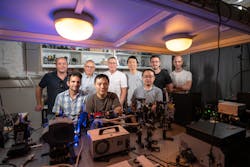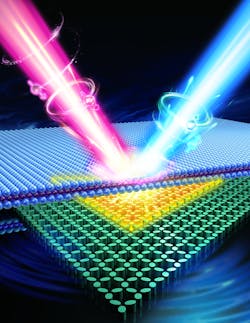Technion team achieves coherent, controllable atomic-scale spin-optical laser
By creating a coherent and controllable spin-optical laser based on a single atomic layer of tungsten disulfide (WS2), Technion-Israel Institute of Technology researchers are pushing the boundaries of what’s possible within the realm of spin-optical lasers.
Their advance in spin-optical lasers opens up new horizons for fundamental research and optoelectronic devices via exploiting both electron and photon spins (see video).
“In 2018, we were attracted by the valley pseudospins in two-dimensional (2D) materials, which are believed to be an alternative information carrier to well-known ones such as electron charges and spins—and they’re being widely explored for next-generation valleytronics devices,” says Kexiu Rong, a postdoctoral scholar who led the research and collaborated with a large group of colleagues from Technion’s Atomic-Scale Photonics Laboratory, the Laboratory for Nanoscale Electronic Materials and Devices, and Tel Aviv University (see Fig. 1).
Valleytronics is a promising quantum computing field, in which electrons flow through the lattice of a 2D semiconductor as a wave with two distinct electronic valleys. Excited electrons accumulate in one valley and acquire a valley index (either -K’ or K’), which can be used to represent one or zero to encode information.
Spin-optical lasers
Spin-optical lasers combine photonic modes (eigenmodes of a cavity) and electronic transitions (emission of a gain material) to provide a way to explore the exchange of spin information between electrons and photons and to develop advanced optoelectronic devices.
“To achieve high-quality photonic spin-split modes, we constructed photonic spin lattices with different symmetry properties, which compromise an inversion-asymmetry core and inversion-symmetry cladding integrated with a WS2 monolayer to create laterally confined spin-valley states (see Fig. 2),” says Rong. “Both lattices are photonic analogues of ordered electronic spin lattices emulated by anisotropic and inhomogeneous nanostructures.”
The essential inversion-asymmetry lattice has two important properties: First, a controllable spin-dependent reciprocal lattice vector due to space-variant geometric phases from its constituting inhomogeneous-anisotropic nanoholes. This vector splits a spin-degenerate band into two spin-polarized branches in momentum space, a.k.a. the photonic Rashba effect.
Second, a pair of high-quality symmetry-enabled (quasi-) bound states in the continuum, or ±K (corners of the Brillouin zone) photonic spin-valley states, at the band edges of the spin-split branches. These two spin-split states are “bound states” within the continuum because they remain highly confined in space due to a symmetry mismatch between their near fields and outgoing propagation fields. And the two states form a coherence superposition state with equal amplitudes.
“To obtain spin-controllable electronic transitions, we used a WS2 monolayer as the gain material because this direct-bandgap transition metal dichalcogenide possesses unique valley pseudospins that have been widely investigated as an alternative information carrier in valleytronics,” says Professor Elad Koren, head of the Laboratory for Nanoscale Electronic Materials and Devices at Tel Aviv University. “Their ±K’ valley excitons—radiated as in-plane spin-polarized dipole emitters—can be selectively excited by spin-polarized light according to a valley-contrasted selection rule, which enables active control of spin-optical light sources without magnetic fields.”
Within the monolayer-integrated spin-valley microcavities, ±K’ valley excitons couple to ±K spin-valley states, thanks to polarization matching, and spin-optical excitonic lasing is achieved at room temperatures through strong optical feedback.
“Meanwhile, ±K’ valley excitons (initially without a phase correlation) are driven by the lasing mechanism to find the minimum-loss state of the system, which leads them to re-establish a phase-locked correlation according to the opposite geometric phases of ±K spin-valley states,” says Professor Ezra Hasman, head of the Atomic-Scale Photonics Laboratory.
This lasing mechanism-driven valley coherence removes the need for cryogenic temperatures to suppress the intervalley scattering. “And the minimum-loss state of the Rashba monolayer laser can be regulated to be satisfied (broken) via a linear (circular) pump polarization, which provides a way to control the lasing intensity and spatial coherence,” Hasman adds.
Goodbye magnetic fields, cryogenic temps
A key takeaway of the group’s work is that by focusing on both photonic modes’ design and monolayer gain material selection, they solved the challenge of spin degeneracy removal of coherent light sources—without magnetic fields and at room temperature.
Both electrons and photons possess an intrinsic angular momentum known as spin, which has been researched extensively in spintronics and spin-optics ranging from fundamental research to applications.
“To construct spin-optical light sources, a prerequisite is to lift the spin degeneracy between the two opposite spin states either in their photonic or electronic parts,” explains Rong. “This is usually accomplished by applying magnetic fields under a Faraday or Zeeman effect, although these approaches generally require strong magnetic fields and can’t produce miniaturized sources.”
One other promising method takes advantage of artificial magnetic fields for photonic spin-split states in momentum space, underpinned by a geometric phase mechanism. But Rong points out that, unfortunately, previous observations of spin-split states relied heavily on propagation modes with low quality factors that impose undesirable limitations on spatial and temporal coherence of the sources.
“Furthermore, active control of these sources suffers from an unavailability of nontrivial spin-controllable properties in bulky gain materials—especially without magnetic fields at room temperature,” Rong says.
Lasing mechanism
Perhaps the most surprising aspect of the team’s work is that it goes far beyond creating a monolayer laser. “Our lasing mechanism leads to long-sought valley coherence within the WS2 monolayer, without cryogenic temperatures, and the lasing intensity and spatial coherence are controlled by different pump polarizations,” says Hasman.
The team’s lasing mechanism drives ±K’ valley excitons—initially without a phase correlation—to find the minimum-loss state of the system, which causes them to re-establish a phase-locked correlation based on the opposite geometric phases of ±K spin-valley states.
“This lasing-mechanism-driven valley coherence removes the need for cryogenic temperatures to suppress the intervalley scattering,” Hasman adds. “Moreover, the minimum-loss state of the Rashba monolayer can be regulated to be satisfied (broken) via a linear (circular) pump polarization, which provides a way to control the lasing intensity and spatial coherence.”
Quantum exploration
The photonic spin-valley Rashba effect unveiled by Rong and colleagues provides a general mechanism to construct surface-emitting spin-optical light sources. And the valley coherence they demonstrated within the monolayer-integrated spin-valley microcavity is a step toward achieving entanglement between ±K’ valley excitons for quantum information via qubits.
“Our monolayer-integrated spin-valley microcavities can serve as a multidimensional platform to study coherent spin-dependent phenomena within both classical and quantum regimes by exploring electron and photon spins,” says Rong. “One of our future goals is to study this structure platform for new effects and applications within the quantum regime.”
FURTHER READING
K. Rong et al., Nat. Mater., 22, 1085–1093 (2023); https://doi.org/10.1038/s41563-023-01603-3.

Sally Cole Johnson | Editor in Chief
Sally Cole Johnson, Laser Focus World’s editor in chief, is a science and technology journalist who specializes in physics and semiconductors.

